Research Proposal: Cloud Computing Transforming Construction Industry
VerifiedAdded on 2023/06/04
|14
|3965
|210
Report
AI Summary
This report investigates the transformative potential of cloud computing within the construction industry, addressing the main research question of how cloud computing will reshape the industry's future. It explores sub-questions related to the necessity, beneficiaries, implications, and stakeholder support for cloud computing in construction. The report identifies the industry's problem of fragmented data management and slow technological adoption, highlighting the benefits of cloud computing in terms of time and resource savings, transparency, and reduced fraudulent activities. It reviews literature on cloud computing trends, including mobile technology, collaboration technology, and 3D modeling, and discusses the importance of cloud computing in connecting employees, facilitating real-time data sharing, and managing material price fluctuations. The report also touches on the initial resistance to technology adoption and the growing acceptance of cloud computing within the construction industry.
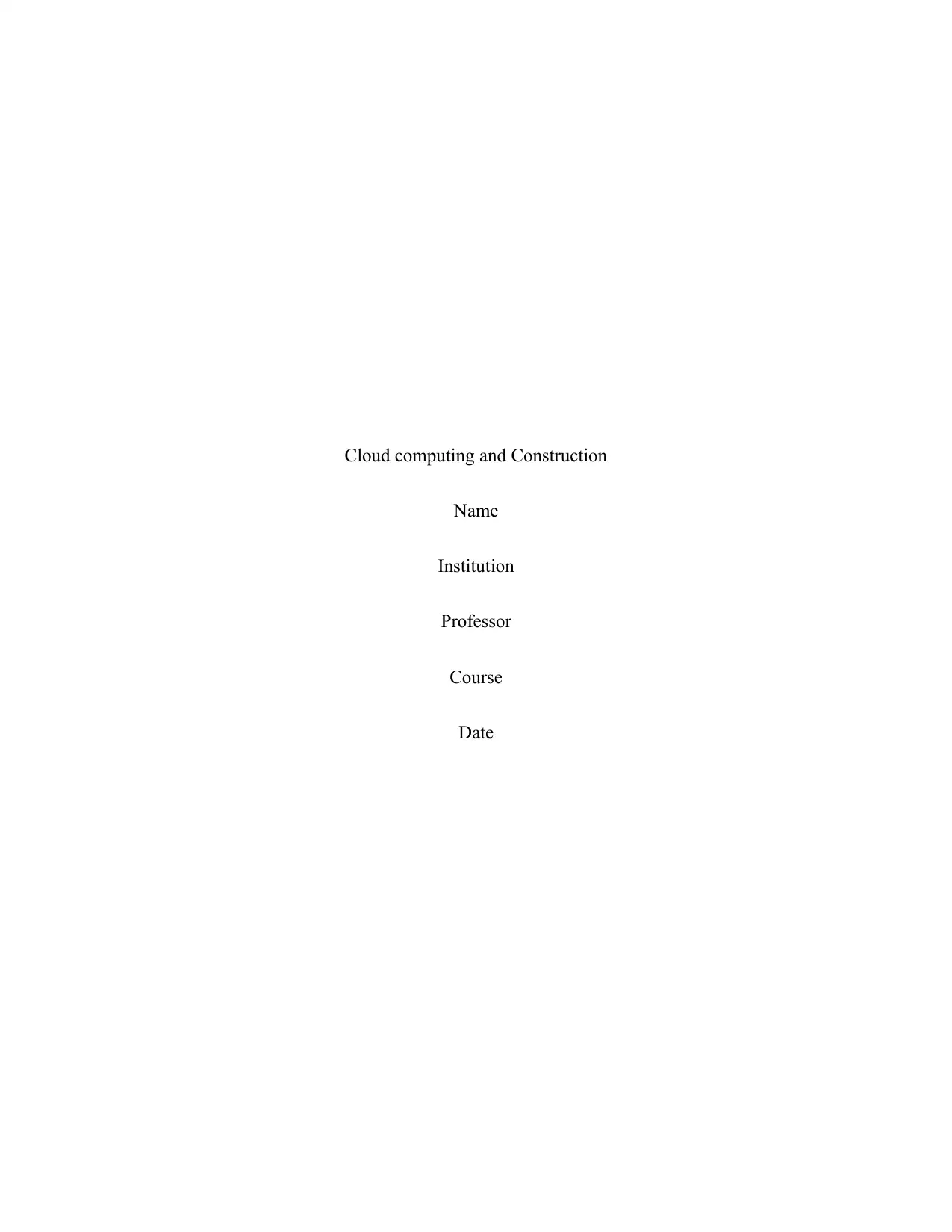
Cloud computing and Construction
Name
Institution
Professor
Course
Date
Name
Institution
Professor
Course
Date
Paraphrase This Document
Need a fresh take? Get an instant paraphrase of this document with our AI Paraphraser
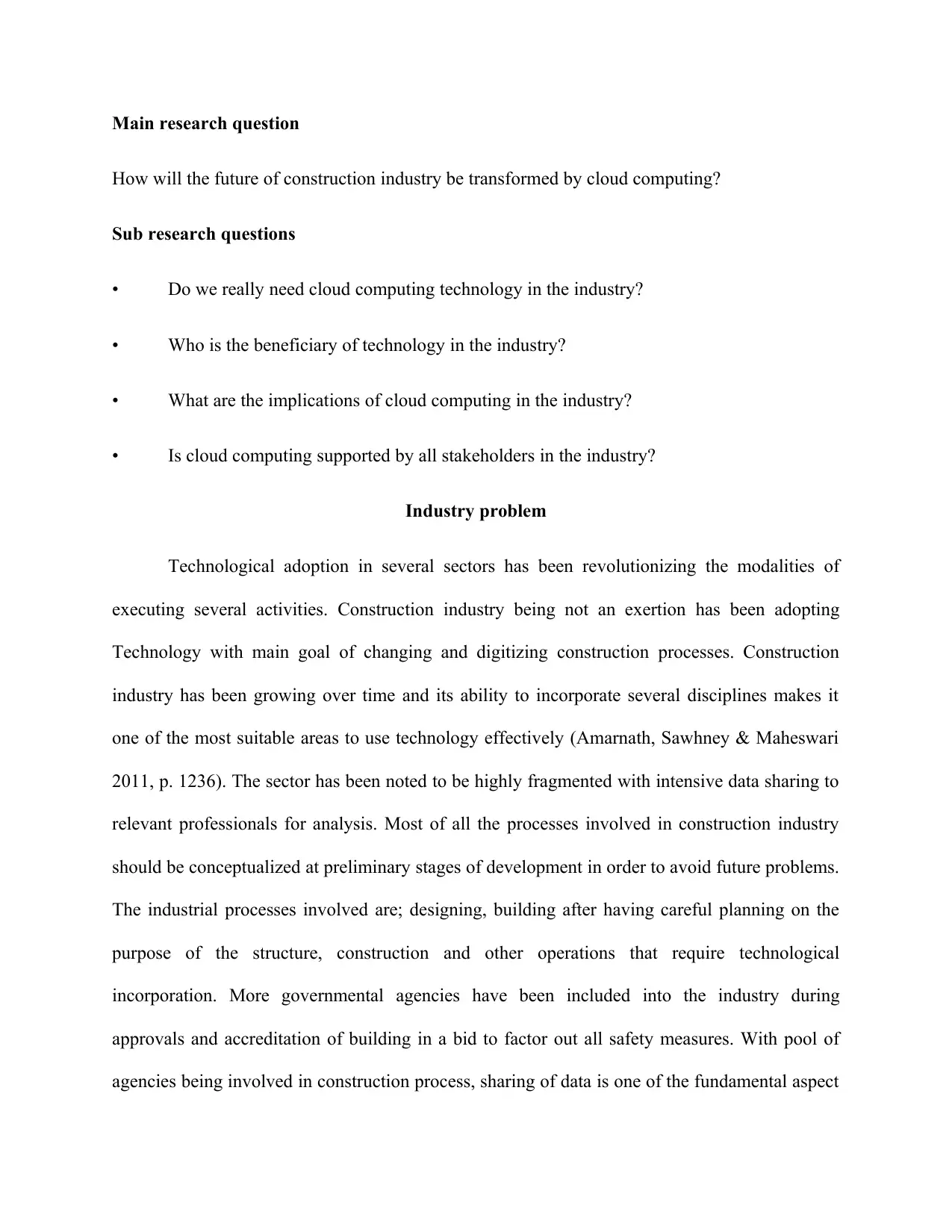
Main research question
How will the future of construction industry be transformed by cloud computing?
Sub research questions
• Do we really need cloud computing technology in the industry?
• Who is the beneficiary of technology in the industry?
• What are the implications of cloud computing in the industry?
• Is cloud computing supported by all stakeholders in the industry?
Industry problem
Technological adoption in several sectors has been revolutionizing the modalities of
executing several activities. Construction industry being not an exertion has been adopting
Technology with main goal of changing and digitizing construction processes. Construction
industry has been growing over time and its ability to incorporate several disciplines makes it
one of the most suitable areas to use technology effectively (Amarnath, Sawhney & Maheswari
2011, p. 1236). The sector has been noted to be highly fragmented with intensive data sharing to
relevant professionals for analysis. Most of all the processes involved in construction industry
should be conceptualized at preliminary stages of development in order to avoid future problems.
The industrial processes involved are; designing, building after having careful planning on the
purpose of the structure, construction and other operations that require technological
incorporation. More governmental agencies have been included into the industry during
approvals and accreditation of building in a bid to factor out all safety measures. With pool of
agencies being involved in construction process, sharing of data is one of the fundamental aspect
How will the future of construction industry be transformed by cloud computing?
Sub research questions
• Do we really need cloud computing technology in the industry?
• Who is the beneficiary of technology in the industry?
• What are the implications of cloud computing in the industry?
• Is cloud computing supported by all stakeholders in the industry?
Industry problem
Technological adoption in several sectors has been revolutionizing the modalities of
executing several activities. Construction industry being not an exertion has been adopting
Technology with main goal of changing and digitizing construction processes. Construction
industry has been growing over time and its ability to incorporate several disciplines makes it
one of the most suitable areas to use technology effectively (Amarnath, Sawhney & Maheswari
2011, p. 1236). The sector has been noted to be highly fragmented with intensive data sharing to
relevant professionals for analysis. Most of all the processes involved in construction industry
should be conceptualized at preliminary stages of development in order to avoid future problems.
The industrial processes involved are; designing, building after having careful planning on the
purpose of the structure, construction and other operations that require technological
incorporation. More governmental agencies have been included into the industry during
approvals and accreditation of building in a bid to factor out all safety measures. With pool of
agencies being involved in construction process, sharing of data is one of the fundamental aspect
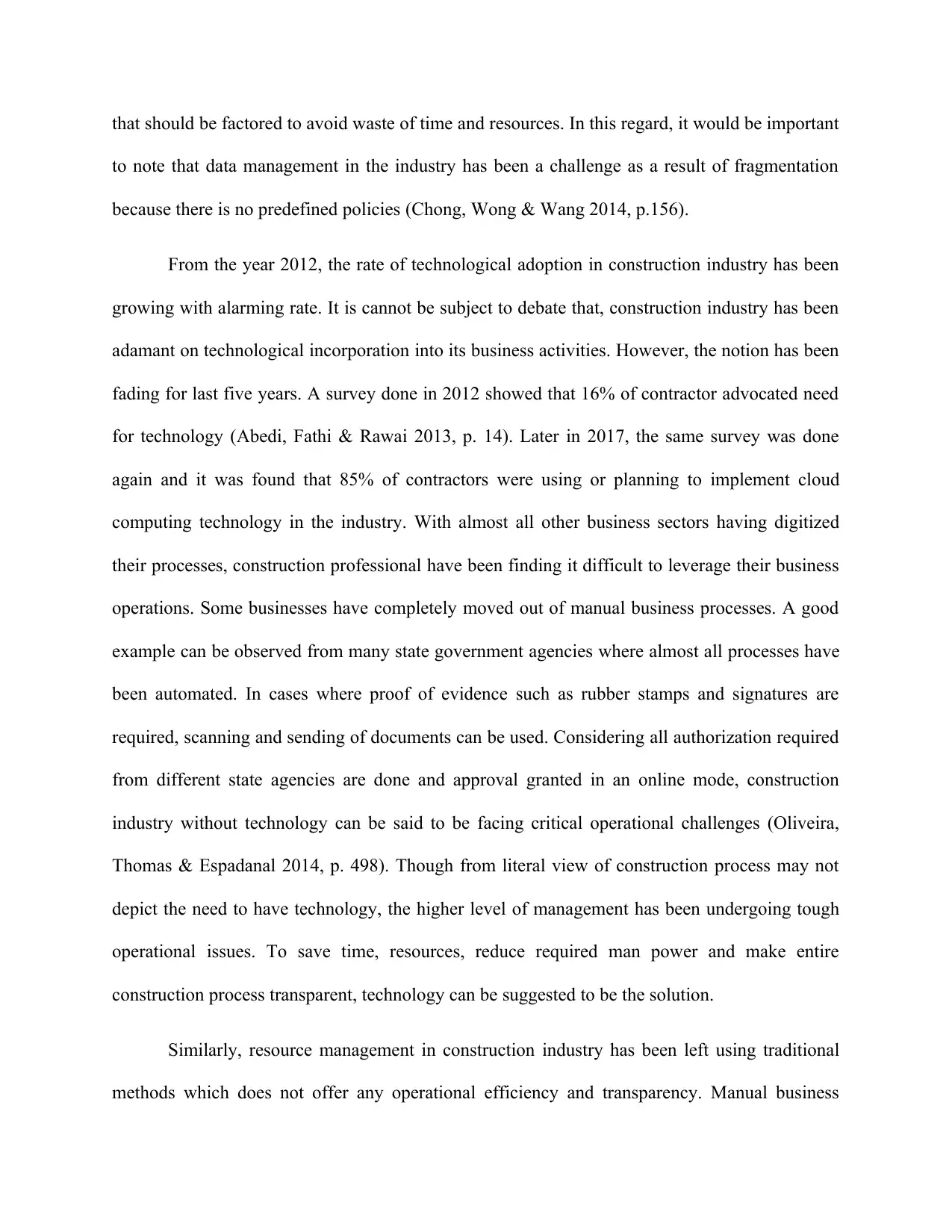
that should be factored to avoid waste of time and resources. In this regard, it would be important
to note that data management in the industry has been a challenge as a result of fragmentation
because there is no predefined policies (Chong, Wong & Wang 2014, p.156).
From the year 2012, the rate of technological adoption in construction industry has been
growing with alarming rate. It is cannot be subject to debate that, construction industry has been
adamant on technological incorporation into its business activities. However, the notion has been
fading for last five years. A survey done in 2012 showed that 16% of contractor advocated need
for technology (Abedi, Fathi & Rawai 2013, p. 14). Later in 2017, the same survey was done
again and it was found that 85% of contractors were using or planning to implement cloud
computing technology in the industry. With almost all other business sectors having digitized
their processes, construction professional have been finding it difficult to leverage their business
operations. Some businesses have completely moved out of manual business processes. A good
example can be observed from many state government agencies where almost all processes have
been automated. In cases where proof of evidence such as rubber stamps and signatures are
required, scanning and sending of documents can be used. Considering all authorization required
from different state agencies are done and approval granted in an online mode, construction
industry without technology can be said to be facing critical operational challenges (Oliveira,
Thomas & Espadanal 2014, p. 498). Though from literal view of construction process may not
depict the need to have technology, the higher level of management has been undergoing tough
operational issues. To save time, resources, reduce required man power and make entire
construction process transparent, technology can be suggested to be the solution.
Similarly, resource management in construction industry has been left using traditional
methods which does not offer any operational efficiency and transparency. Manual business
to note that data management in the industry has been a challenge as a result of fragmentation
because there is no predefined policies (Chong, Wong & Wang 2014, p.156).
From the year 2012, the rate of technological adoption in construction industry has been
growing with alarming rate. It is cannot be subject to debate that, construction industry has been
adamant on technological incorporation into its business activities. However, the notion has been
fading for last five years. A survey done in 2012 showed that 16% of contractor advocated need
for technology (Abedi, Fathi & Rawai 2013, p. 14). Later in 2017, the same survey was done
again and it was found that 85% of contractors were using or planning to implement cloud
computing technology in the industry. With almost all other business sectors having digitized
their processes, construction professional have been finding it difficult to leverage their business
operations. Some businesses have completely moved out of manual business processes. A good
example can be observed from many state government agencies where almost all processes have
been automated. In cases where proof of evidence such as rubber stamps and signatures are
required, scanning and sending of documents can be used. Considering all authorization required
from different state agencies are done and approval granted in an online mode, construction
industry without technology can be said to be facing critical operational challenges (Oliveira,
Thomas & Espadanal 2014, p. 498). Though from literal view of construction process may not
depict the need to have technology, the higher level of management has been undergoing tough
operational issues. To save time, resources, reduce required man power and make entire
construction process transparent, technology can be suggested to be the solution.
Similarly, resource management in construction industry has been left using traditional
methods which does not offer any operational efficiency and transparency. Manual business
⊘ This is a preview!⊘
Do you want full access?
Subscribe today to unlock all pages.

Trusted by 1+ million students worldwide
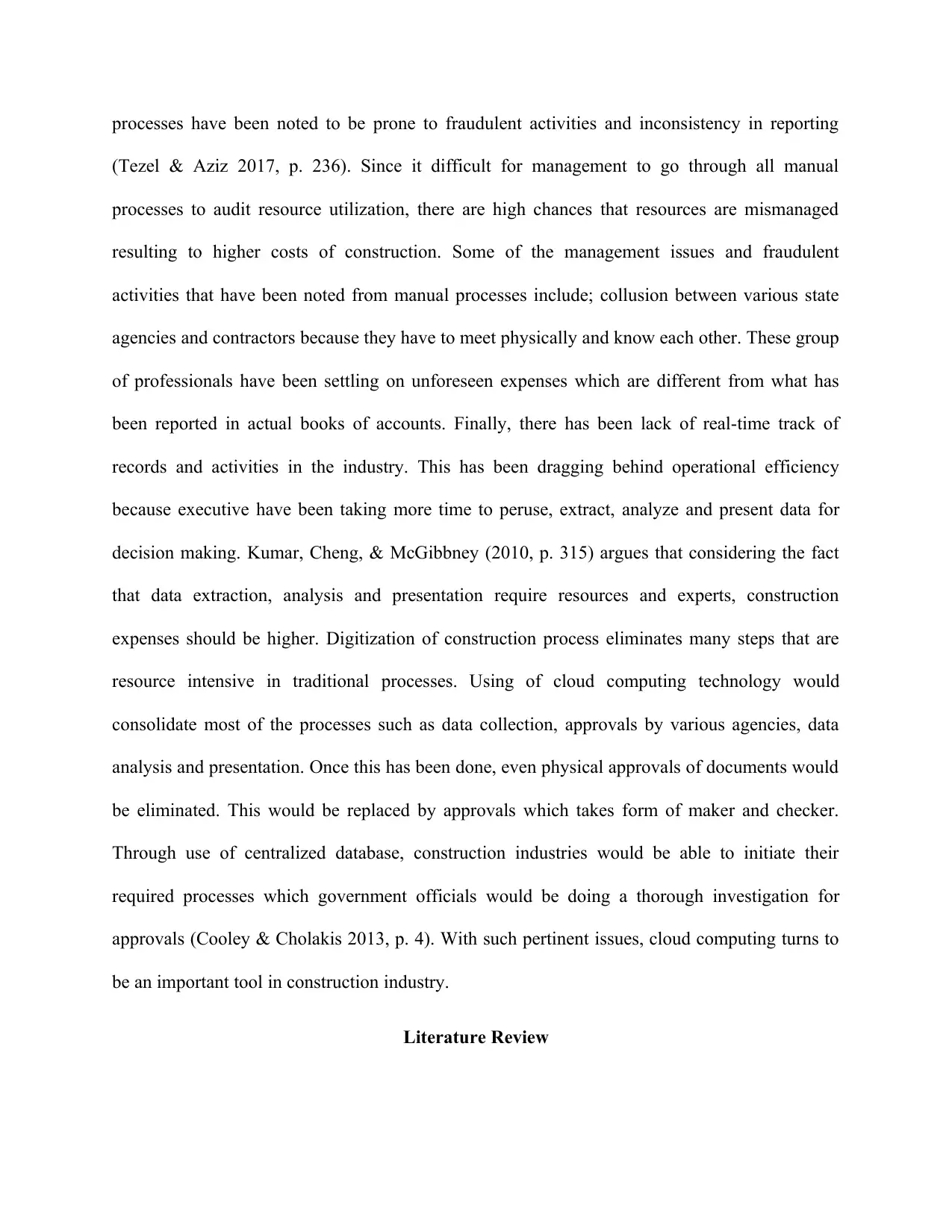
processes have been noted to be prone to fraudulent activities and inconsistency in reporting
(Tezel & Aziz 2017, p. 236). Since it difficult for management to go through all manual
processes to audit resource utilization, there are high chances that resources are mismanaged
resulting to higher costs of construction. Some of the management issues and fraudulent
activities that have been noted from manual processes include; collusion between various state
agencies and contractors because they have to meet physically and know each other. These group
of professionals have been settling on unforeseen expenses which are different from what has
been reported in actual books of accounts. Finally, there has been lack of real-time track of
records and activities in the industry. This has been dragging behind operational efficiency
because executive have been taking more time to peruse, extract, analyze and present data for
decision making. Kumar, Cheng, & McGibbney (2010, p. 315) argues that considering the fact
that data extraction, analysis and presentation require resources and experts, construction
expenses should be higher. Digitization of construction process eliminates many steps that are
resource intensive in traditional processes. Using of cloud computing technology would
consolidate most of the processes such as data collection, approvals by various agencies, data
analysis and presentation. Once this has been done, even physical approvals of documents would
be eliminated. This would be replaced by approvals which takes form of maker and checker.
Through use of centralized database, construction industries would be able to initiate their
required processes which government officials would be doing a thorough investigation for
approvals (Cooley & Cholakis 2013, p. 4). With such pertinent issues, cloud computing turns to
be an important tool in construction industry.
Literature Review
(Tezel & Aziz 2017, p. 236). Since it difficult for management to go through all manual
processes to audit resource utilization, there are high chances that resources are mismanaged
resulting to higher costs of construction. Some of the management issues and fraudulent
activities that have been noted from manual processes include; collusion between various state
agencies and contractors because they have to meet physically and know each other. These group
of professionals have been settling on unforeseen expenses which are different from what has
been reported in actual books of accounts. Finally, there has been lack of real-time track of
records and activities in the industry. This has been dragging behind operational efficiency
because executive have been taking more time to peruse, extract, analyze and present data for
decision making. Kumar, Cheng, & McGibbney (2010, p. 315) argues that considering the fact
that data extraction, analysis and presentation require resources and experts, construction
expenses should be higher. Digitization of construction process eliminates many steps that are
resource intensive in traditional processes. Using of cloud computing technology would
consolidate most of the processes such as data collection, approvals by various agencies, data
analysis and presentation. Once this has been done, even physical approvals of documents would
be eliminated. This would be replaced by approvals which takes form of maker and checker.
Through use of centralized database, construction industries would be able to initiate their
required processes which government officials would be doing a thorough investigation for
approvals (Cooley & Cholakis 2013, p. 4). With such pertinent issues, cloud computing turns to
be an important tool in construction industry.
Literature Review
Paraphrase This Document
Need a fresh take? Get an instant paraphrase of this document with our AI Paraphraser
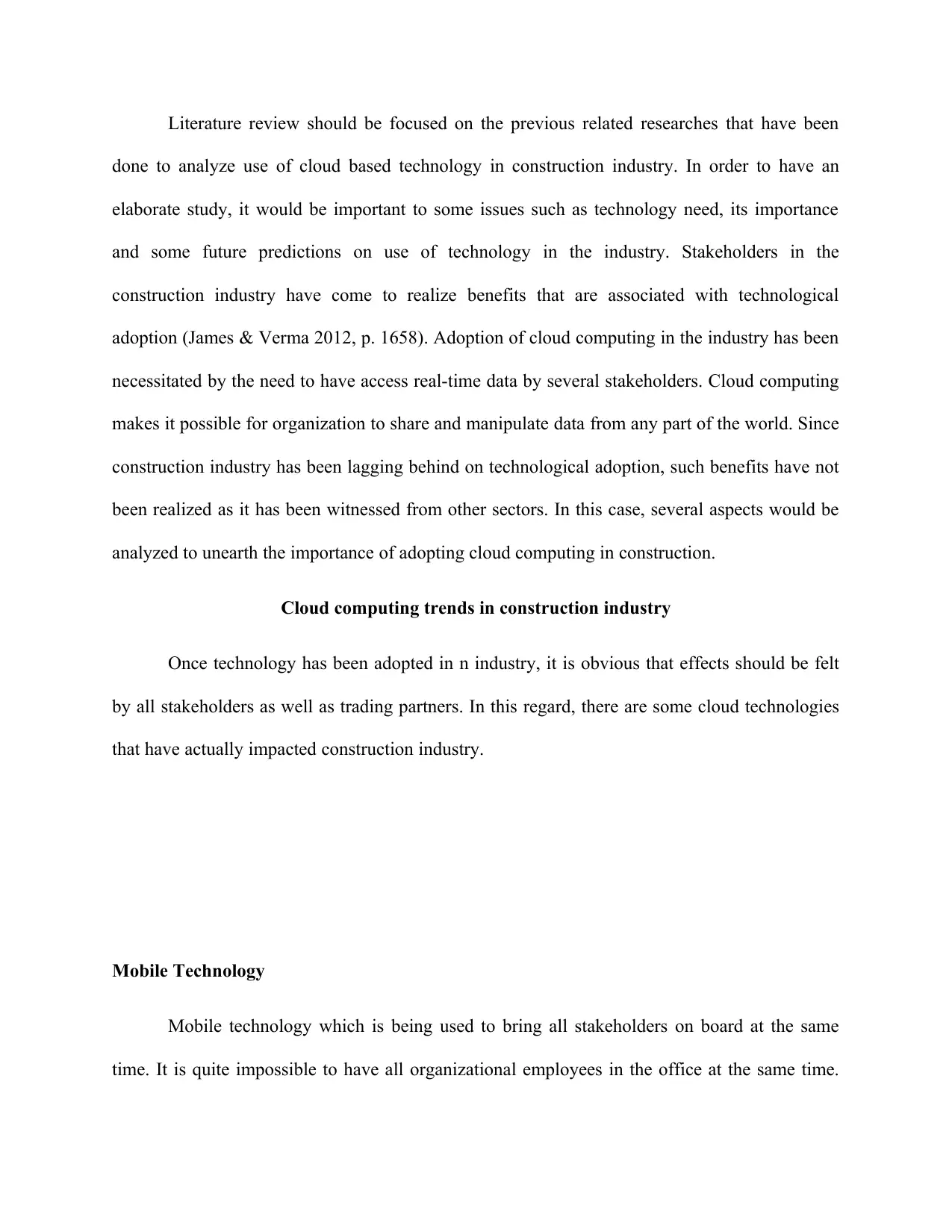
Literature review should be focused on the previous related researches that have been
done to analyze use of cloud based technology in construction industry. In order to have an
elaborate study, it would be important to some issues such as technology need, its importance
and some future predictions on use of technology in the industry. Stakeholders in the
construction industry have come to realize benefits that are associated with technological
adoption (James & Verma 2012, p. 1658). Adoption of cloud computing in the industry has been
necessitated by the need to have access real-time data by several stakeholders. Cloud computing
makes it possible for organization to share and manipulate data from any part of the world. Since
construction industry has been lagging behind on technological adoption, such benefits have not
been realized as it has been witnessed from other sectors. In this case, several aspects would be
analyzed to unearth the importance of adopting cloud computing in construction.
Cloud computing trends in construction industry
Once technology has been adopted in n industry, it is obvious that effects should be felt
by all stakeholders as well as trading partners. In this regard, there are some cloud technologies
that have actually impacted construction industry.
Mobile Technology
Mobile technology which is being used to bring all stakeholders on board at the same
time. It is quite impossible to have all organizational employees in the office at the same time.
done to analyze use of cloud based technology in construction industry. In order to have an
elaborate study, it would be important to some issues such as technology need, its importance
and some future predictions on use of technology in the industry. Stakeholders in the
construction industry have come to realize benefits that are associated with technological
adoption (James & Verma 2012, p. 1658). Adoption of cloud computing in the industry has been
necessitated by the need to have access real-time data by several stakeholders. Cloud computing
makes it possible for organization to share and manipulate data from any part of the world. Since
construction industry has been lagging behind on technological adoption, such benefits have not
been realized as it has been witnessed from other sectors. In this case, several aspects would be
analyzed to unearth the importance of adopting cloud computing in construction.
Cloud computing trends in construction industry
Once technology has been adopted in n industry, it is obvious that effects should be felt
by all stakeholders as well as trading partners. In this regard, there are some cloud technologies
that have actually impacted construction industry.
Mobile Technology
Mobile technology which is being used to bring all stakeholders on board at the same
time. It is quite impossible to have all organizational employees in the office at the same time.
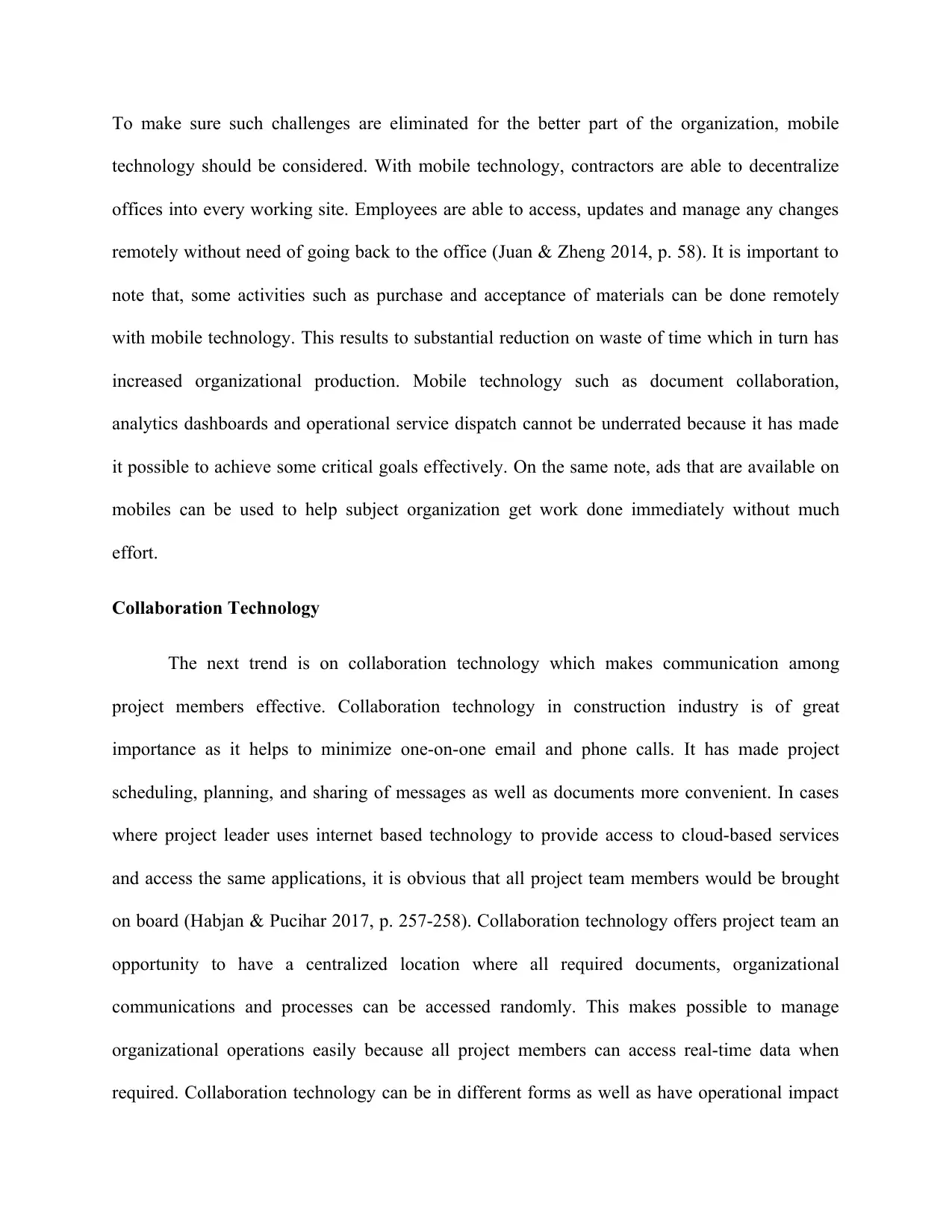
To make sure such challenges are eliminated for the better part of the organization, mobile
technology should be considered. With mobile technology, contractors are able to decentralize
offices into every working site. Employees are able to access, updates and manage any changes
remotely without need of going back to the office (Juan & Zheng 2014, p. 58). It is important to
note that, some activities such as purchase and acceptance of materials can be done remotely
with mobile technology. This results to substantial reduction on waste of time which in turn has
increased organizational production. Mobile technology such as document collaboration,
analytics dashboards and operational service dispatch cannot be underrated because it has made
it possible to achieve some critical goals effectively. On the same note, ads that are available on
mobiles can be used to help subject organization get work done immediately without much
effort.
Collaboration Technology
The next trend is on collaboration technology which makes communication among
project members effective. Collaboration technology in construction industry is of great
importance as it helps to minimize one-on-one email and phone calls. It has made project
scheduling, planning, and sharing of messages as well as documents more convenient. In cases
where project leader uses internet based technology to provide access to cloud-based services
and access the same applications, it is obvious that all project team members would be brought
on board (Habjan & Pucihar 2017, p. 257-258). Collaboration technology offers project team an
opportunity to have a centralized location where all required documents, organizational
communications and processes can be accessed randomly. This makes possible to manage
organizational operations easily because all project members can access real-time data when
required. Collaboration technology can be in different forms as well as have operational impact
technology should be considered. With mobile technology, contractors are able to decentralize
offices into every working site. Employees are able to access, updates and manage any changes
remotely without need of going back to the office (Juan & Zheng 2014, p. 58). It is important to
note that, some activities such as purchase and acceptance of materials can be done remotely
with mobile technology. This results to substantial reduction on waste of time which in turn has
increased organizational production. Mobile technology such as document collaboration,
analytics dashboards and operational service dispatch cannot be underrated because it has made
it possible to achieve some critical goals effectively. On the same note, ads that are available on
mobiles can be used to help subject organization get work done immediately without much
effort.
Collaboration Technology
The next trend is on collaboration technology which makes communication among
project members effective. Collaboration technology in construction industry is of great
importance as it helps to minimize one-on-one email and phone calls. It has made project
scheduling, planning, and sharing of messages as well as documents more convenient. In cases
where project leader uses internet based technology to provide access to cloud-based services
and access the same applications, it is obvious that all project team members would be brought
on board (Habjan & Pucihar 2017, p. 257-258). Collaboration technology offers project team an
opportunity to have a centralized location where all required documents, organizational
communications and processes can be accessed randomly. This makes possible to manage
organizational operations easily because all project members can access real-time data when
required. Collaboration technology can be in different forms as well as have operational impact
⊘ This is a preview!⊘
Do you want full access?
Subscribe today to unlock all pages.

Trusted by 1+ million students worldwide
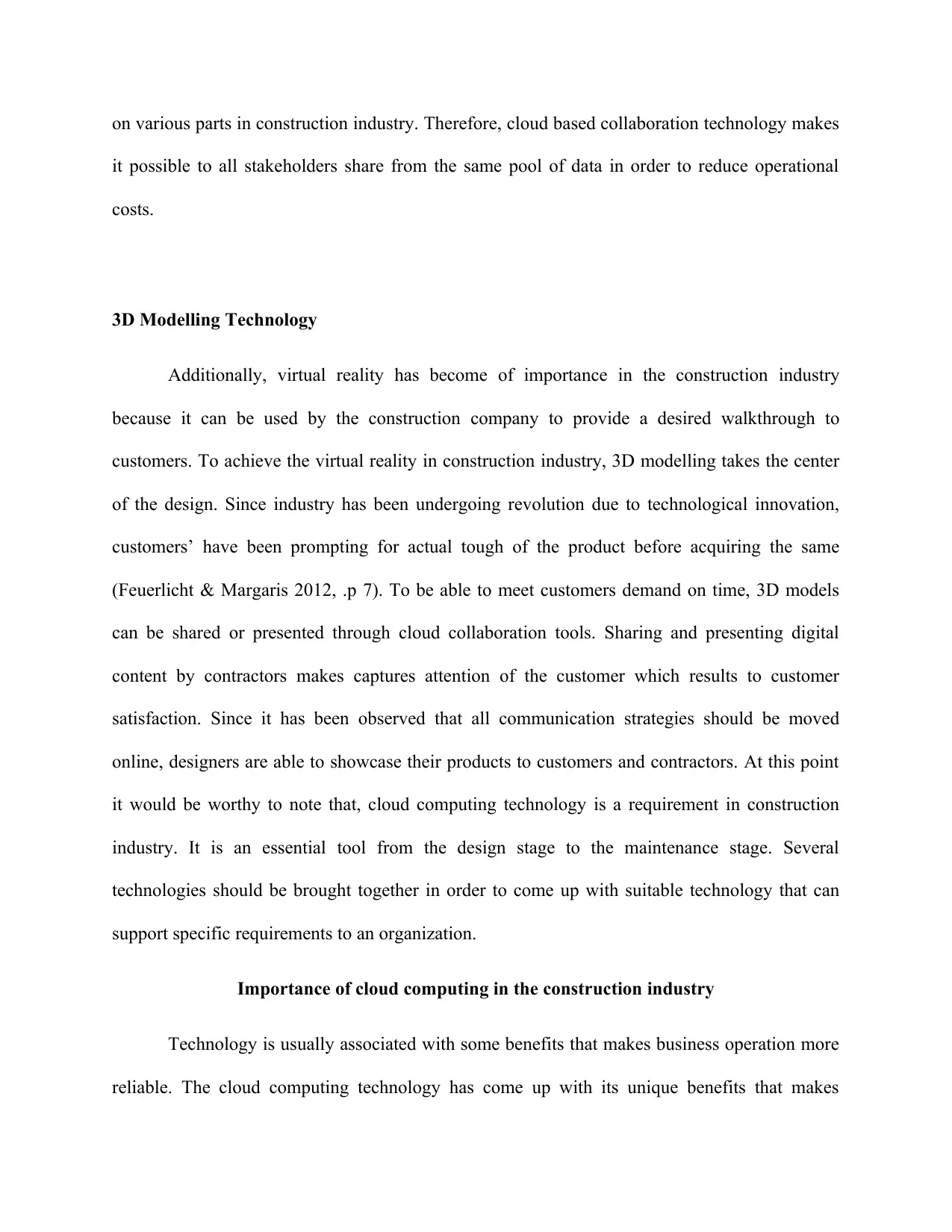
on various parts in construction industry. Therefore, cloud based collaboration technology makes
it possible to all stakeholders share from the same pool of data in order to reduce operational
costs.
3D Modelling Technology
Additionally, virtual reality has become of importance in the construction industry
because it can be used by the construction company to provide a desired walkthrough to
customers. To achieve the virtual reality in construction industry, 3D modelling takes the center
of the design. Since industry has been undergoing revolution due to technological innovation,
customers’ have been prompting for actual tough of the product before acquiring the same
(Feuerlicht & Margaris 2012, .p 7). To be able to meet customers demand on time, 3D models
can be shared or presented through cloud collaboration tools. Sharing and presenting digital
content by contractors makes captures attention of the customer which results to customer
satisfaction. Since it has been observed that all communication strategies should be moved
online, designers are able to showcase their products to customers and contractors. At this point
it would be worthy to note that, cloud computing technology is a requirement in construction
industry. It is an essential tool from the design stage to the maintenance stage. Several
technologies should be brought together in order to come up with suitable technology that can
support specific requirements to an organization.
Importance of cloud computing in the construction industry
Technology is usually associated with some benefits that makes business operation more
reliable. The cloud computing technology has come up with its unique benefits that makes
it possible to all stakeholders share from the same pool of data in order to reduce operational
costs.
3D Modelling Technology
Additionally, virtual reality has become of importance in the construction industry
because it can be used by the construction company to provide a desired walkthrough to
customers. To achieve the virtual reality in construction industry, 3D modelling takes the center
of the design. Since industry has been undergoing revolution due to technological innovation,
customers’ have been prompting for actual tough of the product before acquiring the same
(Feuerlicht & Margaris 2012, .p 7). To be able to meet customers demand on time, 3D models
can be shared or presented through cloud collaboration tools. Sharing and presenting digital
content by contractors makes captures attention of the customer which results to customer
satisfaction. Since it has been observed that all communication strategies should be moved
online, designers are able to showcase their products to customers and contractors. At this point
it would be worthy to note that, cloud computing technology is a requirement in construction
industry. It is an essential tool from the design stage to the maintenance stage. Several
technologies should be brought together in order to come up with suitable technology that can
support specific requirements to an organization.
Importance of cloud computing in the construction industry
Technology is usually associated with some benefits that makes business operation more
reliable. The cloud computing technology has come up with its unique benefits that makes
Paraphrase This Document
Need a fresh take? Get an instant paraphrase of this document with our AI Paraphraser
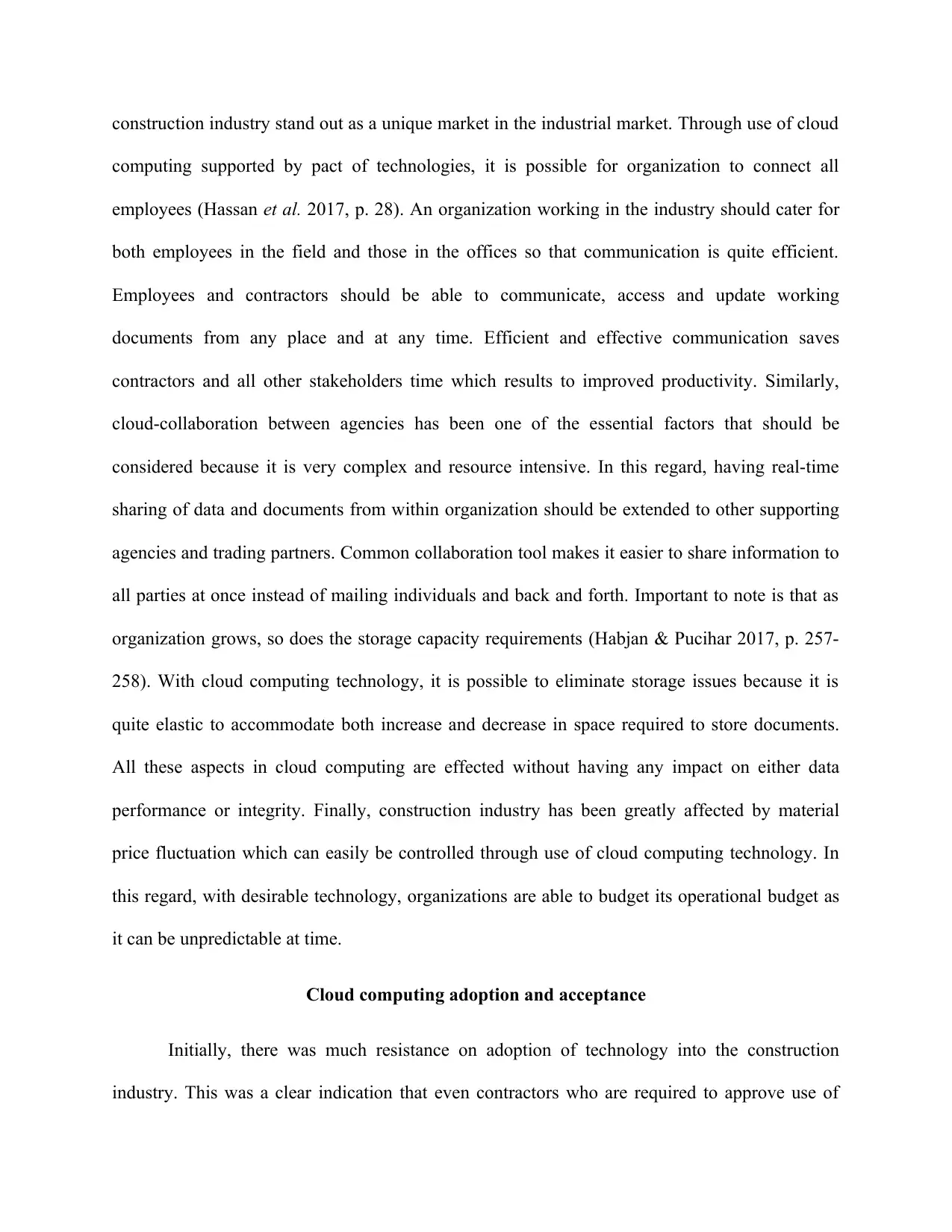
construction industry stand out as a unique market in the industrial market. Through use of cloud
computing supported by pact of technologies, it is possible for organization to connect all
employees (Hassan et al. 2017, p. 28). An organization working in the industry should cater for
both employees in the field and those in the offices so that communication is quite efficient.
Employees and contractors should be able to communicate, access and update working
documents from any place and at any time. Efficient and effective communication saves
contractors and all other stakeholders time which results to improved productivity. Similarly,
cloud-collaboration between agencies has been one of the essential factors that should be
considered because it is very complex and resource intensive. In this regard, having real-time
sharing of data and documents from within organization should be extended to other supporting
agencies and trading partners. Common collaboration tool makes it easier to share information to
all parties at once instead of mailing individuals and back and forth. Important to note is that as
organization grows, so does the storage capacity requirements (Habjan & Pucihar 2017, p. 257-
258). With cloud computing technology, it is possible to eliminate storage issues because it is
quite elastic to accommodate both increase and decrease in space required to store documents.
All these aspects in cloud computing are effected without having any impact on either data
performance or integrity. Finally, construction industry has been greatly affected by material
price fluctuation which can easily be controlled through use of cloud computing technology. In
this regard, with desirable technology, organizations are able to budget its operational budget as
it can be unpredictable at time.
Cloud computing adoption and acceptance
Initially, there was much resistance on adoption of technology into the construction
industry. This was a clear indication that even contractors who are required to approve use of
computing supported by pact of technologies, it is possible for organization to connect all
employees (Hassan et al. 2017, p. 28). An organization working in the industry should cater for
both employees in the field and those in the offices so that communication is quite efficient.
Employees and contractors should be able to communicate, access and update working
documents from any place and at any time. Efficient and effective communication saves
contractors and all other stakeholders time which results to improved productivity. Similarly,
cloud-collaboration between agencies has been one of the essential factors that should be
considered because it is very complex and resource intensive. In this regard, having real-time
sharing of data and documents from within organization should be extended to other supporting
agencies and trading partners. Common collaboration tool makes it easier to share information to
all parties at once instead of mailing individuals and back and forth. Important to note is that as
organization grows, so does the storage capacity requirements (Habjan & Pucihar 2017, p. 257-
258). With cloud computing technology, it is possible to eliminate storage issues because it is
quite elastic to accommodate both increase and decrease in space required to store documents.
All these aspects in cloud computing are effected without having any impact on either data
performance or integrity. Finally, construction industry has been greatly affected by material
price fluctuation which can easily be controlled through use of cloud computing technology. In
this regard, with desirable technology, organizations are able to budget its operational budget as
it can be unpredictable at time.
Cloud computing adoption and acceptance
Initially, there was much resistance on adoption of technology into the construction
industry. This was a clear indication that even contractors who are required to approve use of
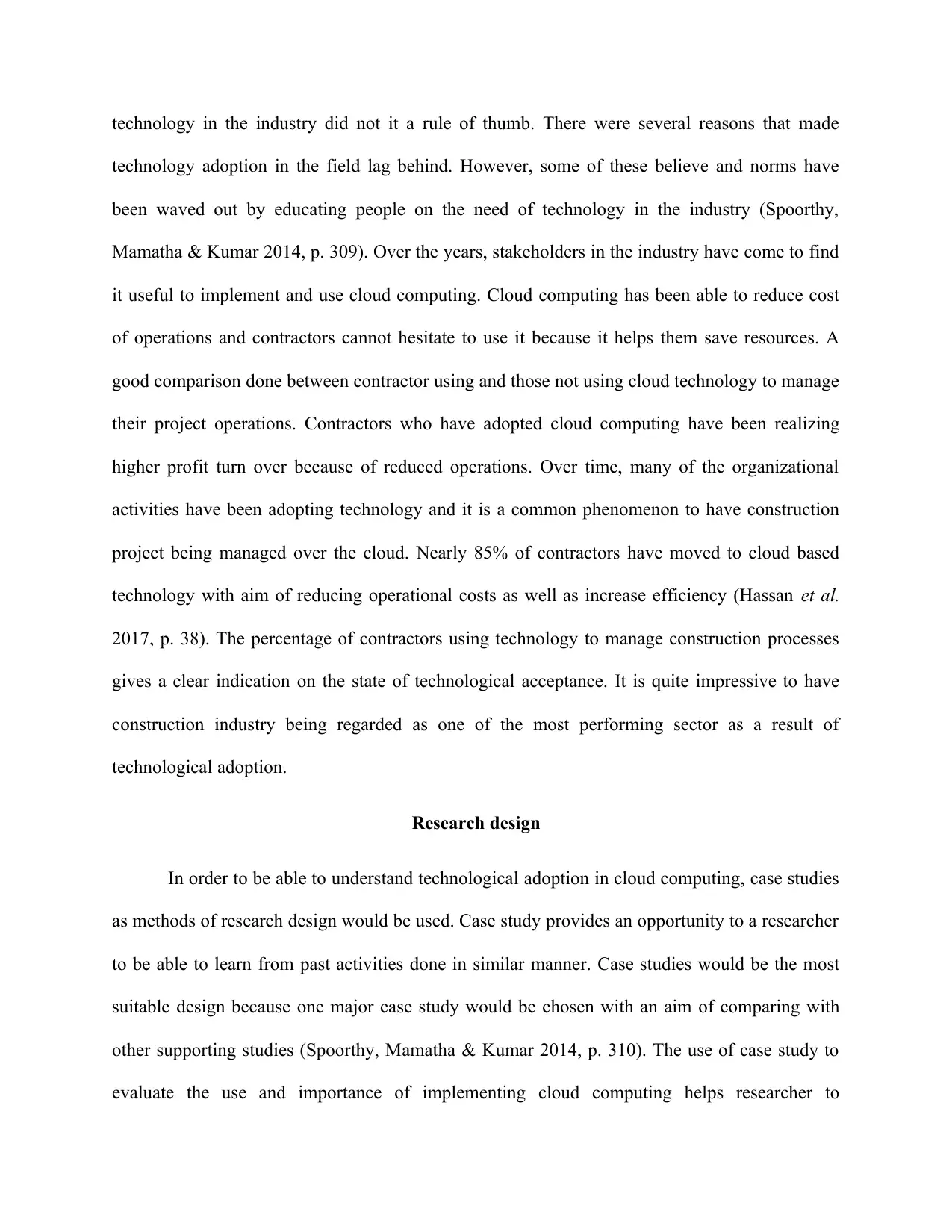
technology in the industry did not it a rule of thumb. There were several reasons that made
technology adoption in the field lag behind. However, some of these believe and norms have
been waved out by educating people on the need of technology in the industry (Spoorthy,
Mamatha & Kumar 2014, p. 309). Over the years, stakeholders in the industry have come to find
it useful to implement and use cloud computing. Cloud computing has been able to reduce cost
of operations and contractors cannot hesitate to use it because it helps them save resources. A
good comparison done between contractor using and those not using cloud technology to manage
their project operations. Contractors who have adopted cloud computing have been realizing
higher profit turn over because of reduced operations. Over time, many of the organizational
activities have been adopting technology and it is a common phenomenon to have construction
project being managed over the cloud. Nearly 85% of contractors have moved to cloud based
technology with aim of reducing operational costs as well as increase efficiency (Hassan et al.
2017, p. 38). The percentage of contractors using technology to manage construction processes
gives a clear indication on the state of technological acceptance. It is quite impressive to have
construction industry being regarded as one of the most performing sector as a result of
technological adoption.
Research design
In order to be able to understand technological adoption in cloud computing, case studies
as methods of research design would be used. Case study provides an opportunity to a researcher
to be able to learn from past activities done in similar manner. Case studies would be the most
suitable design because one major case study would be chosen with an aim of comparing with
other supporting studies (Spoorthy, Mamatha & Kumar 2014, p. 310). The use of case study to
evaluate the use and importance of implementing cloud computing helps researcher to
technology adoption in the field lag behind. However, some of these believe and norms have
been waved out by educating people on the need of technology in the industry (Spoorthy,
Mamatha & Kumar 2014, p. 309). Over the years, stakeholders in the industry have come to find
it useful to implement and use cloud computing. Cloud computing has been able to reduce cost
of operations and contractors cannot hesitate to use it because it helps them save resources. A
good comparison done between contractor using and those not using cloud technology to manage
their project operations. Contractors who have adopted cloud computing have been realizing
higher profit turn over because of reduced operations. Over time, many of the organizational
activities have been adopting technology and it is a common phenomenon to have construction
project being managed over the cloud. Nearly 85% of contractors have moved to cloud based
technology with aim of reducing operational costs as well as increase efficiency (Hassan et al.
2017, p. 38). The percentage of contractors using technology to manage construction processes
gives a clear indication on the state of technological acceptance. It is quite impressive to have
construction industry being regarded as one of the most performing sector as a result of
technological adoption.
Research design
In order to be able to understand technological adoption in cloud computing, case studies
as methods of research design would be used. Case study provides an opportunity to a researcher
to be able to learn from past activities done in similar manner. Case studies would be the most
suitable design because one major case study would be chosen with an aim of comparing with
other supporting studies (Spoorthy, Mamatha & Kumar 2014, p. 310). The use of case study to
evaluate the use and importance of implementing cloud computing helps researcher to
⊘ This is a preview!⊘
Do you want full access?
Subscribe today to unlock all pages.

Trusted by 1+ million students worldwide
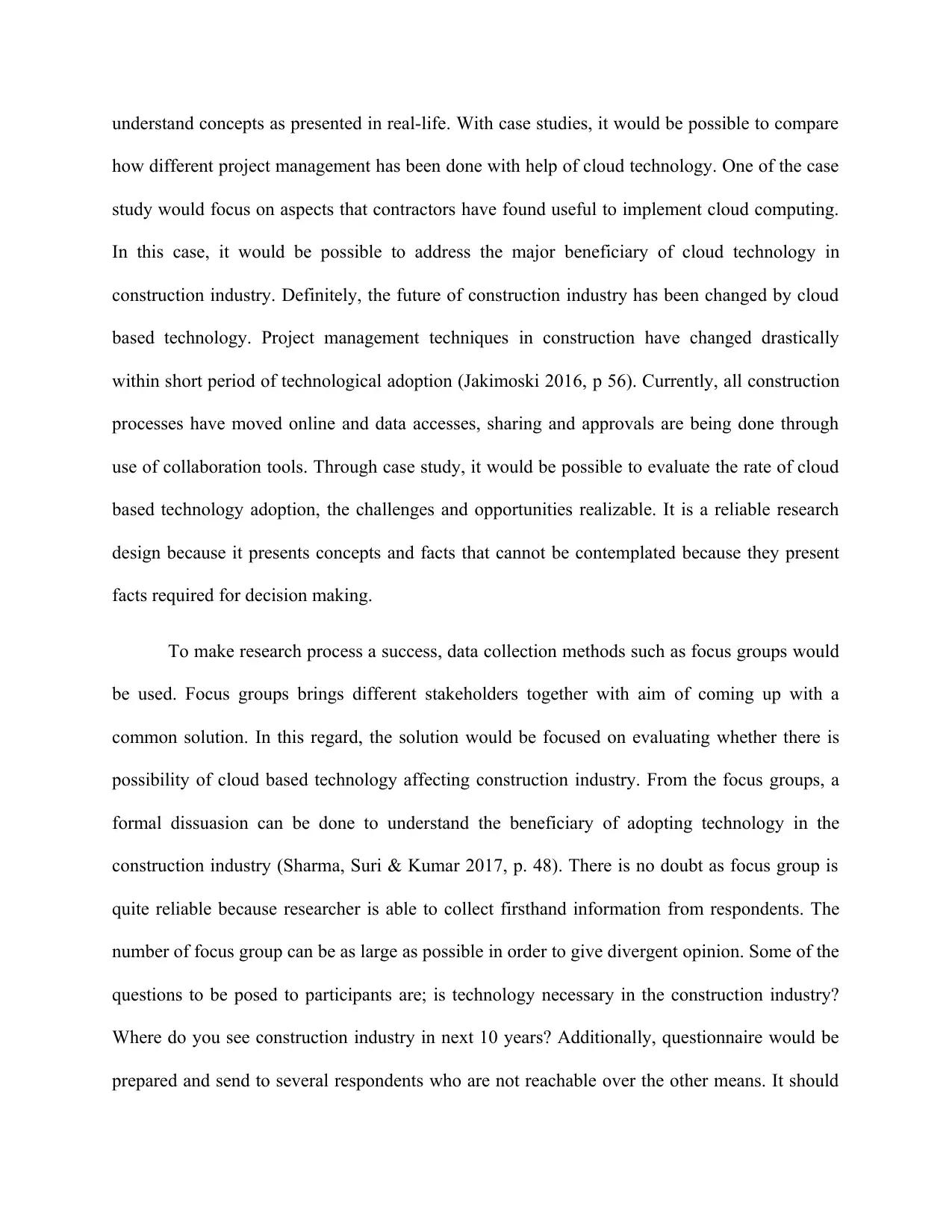
understand concepts as presented in real-life. With case studies, it would be possible to compare
how different project management has been done with help of cloud technology. One of the case
study would focus on aspects that contractors have found useful to implement cloud computing.
In this case, it would be possible to address the major beneficiary of cloud technology in
construction industry. Definitely, the future of construction industry has been changed by cloud
based technology. Project management techniques in construction have changed drastically
within short period of technological adoption (Jakimoski 2016, p 56). Currently, all construction
processes have moved online and data accesses, sharing and approvals are being done through
use of collaboration tools. Through case study, it would be possible to evaluate the rate of cloud
based technology adoption, the challenges and opportunities realizable. It is a reliable research
design because it presents concepts and facts that cannot be contemplated because they present
facts required for decision making.
To make research process a success, data collection methods such as focus groups would
be used. Focus groups brings different stakeholders together with aim of coming up with a
common solution. In this regard, the solution would be focused on evaluating whether there is
possibility of cloud based technology affecting construction industry. From the focus groups, a
formal dissuasion can be done to understand the beneficiary of adopting technology in the
construction industry (Sharma, Suri & Kumar 2017, p. 48). There is no doubt as focus group is
quite reliable because researcher is able to collect firsthand information from respondents. The
number of focus group can be as large as possible in order to give divergent opinion. Some of the
questions to be posed to participants are; is technology necessary in the construction industry?
Where do you see construction industry in next 10 years? Additionally, questionnaire would be
prepared and send to several respondents who are not reachable over the other means. It should
how different project management has been done with help of cloud technology. One of the case
study would focus on aspects that contractors have found useful to implement cloud computing.
In this case, it would be possible to address the major beneficiary of cloud technology in
construction industry. Definitely, the future of construction industry has been changed by cloud
based technology. Project management techniques in construction have changed drastically
within short period of technological adoption (Jakimoski 2016, p 56). Currently, all construction
processes have moved online and data accesses, sharing and approvals are being done through
use of collaboration tools. Through case study, it would be possible to evaluate the rate of cloud
based technology adoption, the challenges and opportunities realizable. It is a reliable research
design because it presents concepts and facts that cannot be contemplated because they present
facts required for decision making.
To make research process a success, data collection methods such as focus groups would
be used. Focus groups brings different stakeholders together with aim of coming up with a
common solution. In this regard, the solution would be focused on evaluating whether there is
possibility of cloud based technology affecting construction industry. From the focus groups, a
formal dissuasion can be done to understand the beneficiary of adopting technology in the
construction industry (Sharma, Suri & Kumar 2017, p. 48). There is no doubt as focus group is
quite reliable because researcher is able to collect firsthand information from respondents. The
number of focus group can be as large as possible in order to give divergent opinion. Some of the
questions to be posed to participants are; is technology necessary in the construction industry?
Where do you see construction industry in next 10 years? Additionally, questionnaire would be
prepared and send to several respondents who are not reachable over the other means. It should
Paraphrase This Document
Need a fresh take? Get an instant paraphrase of this document with our AI Paraphraser
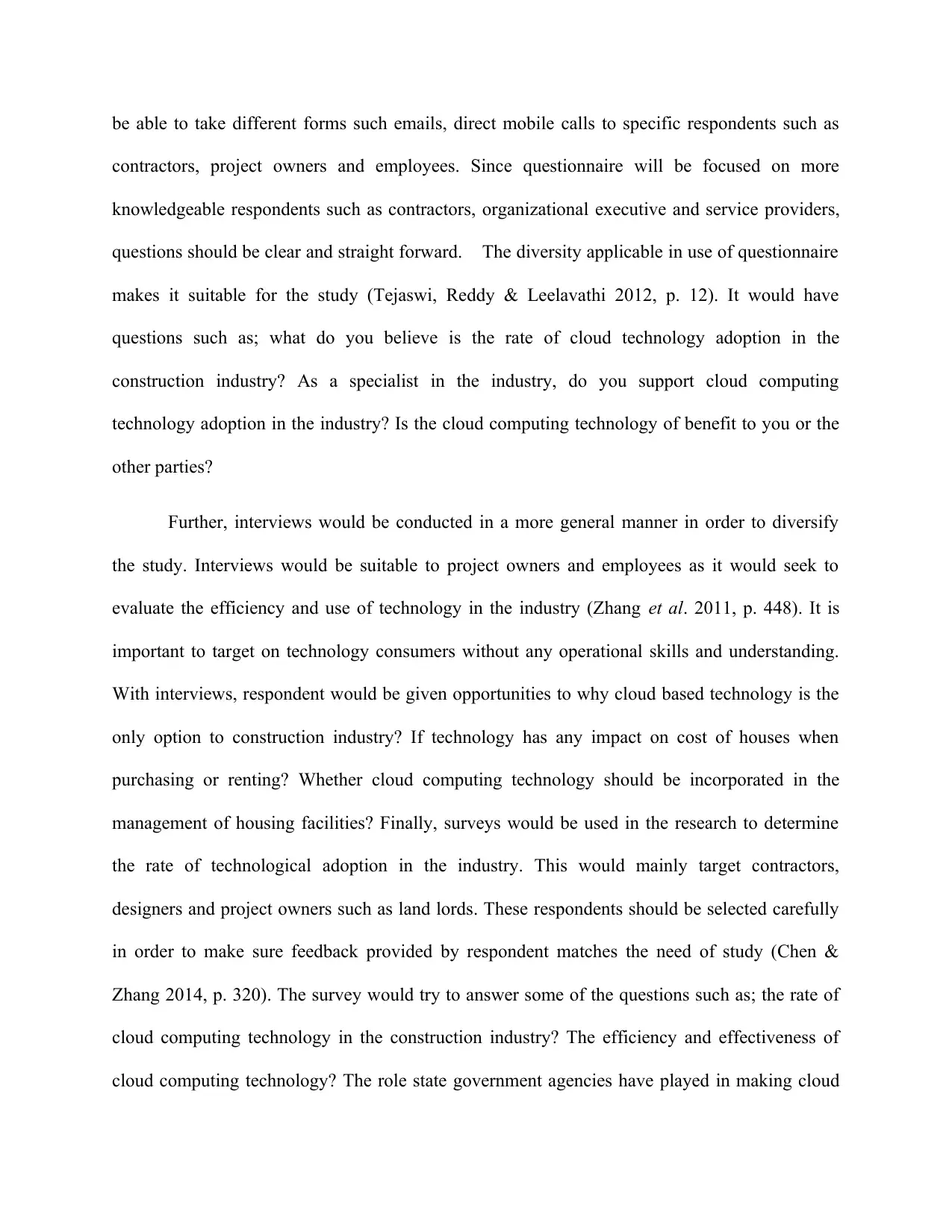
be able to take different forms such emails, direct mobile calls to specific respondents such as
contractors, project owners and employees. Since questionnaire will be focused on more
knowledgeable respondents such as contractors, organizational executive and service providers,
questions should be clear and straight forward. The diversity applicable in use of questionnaire
makes it suitable for the study (Tejaswi, Reddy & Leelavathi 2012, p. 12). It would have
questions such as; what do you believe is the rate of cloud technology adoption in the
construction industry? As a specialist in the industry, do you support cloud computing
technology adoption in the industry? Is the cloud computing technology of benefit to you or the
other parties?
Further, interviews would be conducted in a more general manner in order to diversify
the study. Interviews would be suitable to project owners and employees as it would seek to
evaluate the efficiency and use of technology in the industry (Zhang et al. 2011, p. 448). It is
important to target on technology consumers without any operational skills and understanding.
With interviews, respondent would be given opportunities to why cloud based technology is the
only option to construction industry? If technology has any impact on cost of houses when
purchasing or renting? Whether cloud computing technology should be incorporated in the
management of housing facilities? Finally, surveys would be used in the research to determine
the rate of technological adoption in the industry. This would mainly target contractors,
designers and project owners such as land lords. These respondents should be selected carefully
in order to make sure feedback provided by respondent matches the need of study (Chen &
Zhang 2014, p. 320). The survey would try to answer some of the questions such as; the rate of
cloud computing technology in the construction industry? The efficiency and effectiveness of
cloud computing technology? The role state government agencies have played in making cloud
contractors, project owners and employees. Since questionnaire will be focused on more
knowledgeable respondents such as contractors, organizational executive and service providers,
questions should be clear and straight forward. The diversity applicable in use of questionnaire
makes it suitable for the study (Tejaswi, Reddy & Leelavathi 2012, p. 12). It would have
questions such as; what do you believe is the rate of cloud technology adoption in the
construction industry? As a specialist in the industry, do you support cloud computing
technology adoption in the industry? Is the cloud computing technology of benefit to you or the
other parties?
Further, interviews would be conducted in a more general manner in order to diversify
the study. Interviews would be suitable to project owners and employees as it would seek to
evaluate the efficiency and use of technology in the industry (Zhang et al. 2011, p. 448). It is
important to target on technology consumers without any operational skills and understanding.
With interviews, respondent would be given opportunities to why cloud based technology is the
only option to construction industry? If technology has any impact on cost of houses when
purchasing or renting? Whether cloud computing technology should be incorporated in the
management of housing facilities? Finally, surveys would be used in the research to determine
the rate of technological adoption in the industry. This would mainly target contractors,
designers and project owners such as land lords. These respondents should be selected carefully
in order to make sure feedback provided by respondent matches the need of study (Chen &
Zhang 2014, p. 320). The survey would try to answer some of the questions such as; the rate of
cloud computing technology in the construction industry? The efficiency and effectiveness of
cloud computing technology? The role state government agencies have played in making cloud
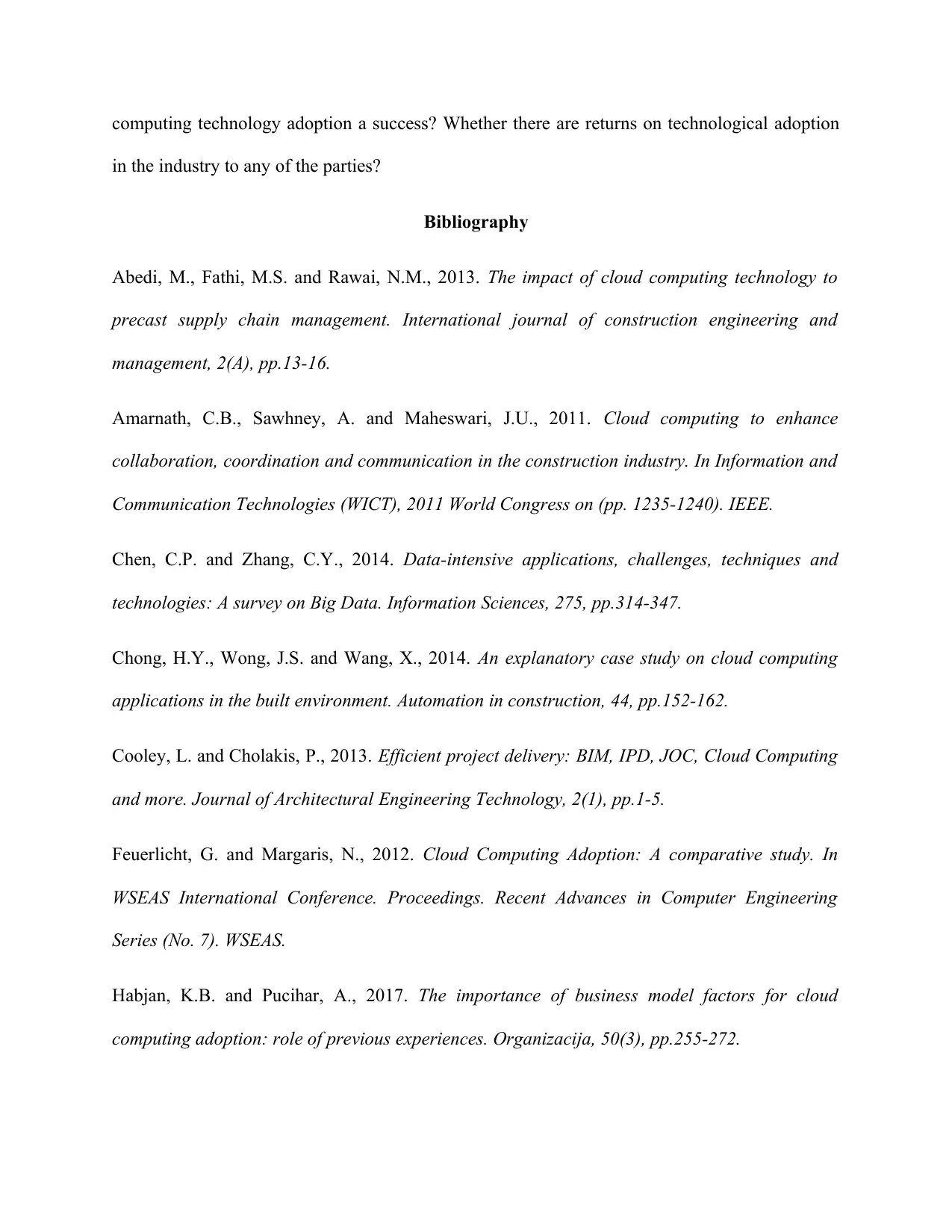
computing technology adoption a success? Whether there are returns on technological adoption
in the industry to any of the parties?
Bibliography
Abedi, M., Fathi, M.S. and Rawai, N.M., 2013. The impact of cloud computing technology to
precast supply chain management. International journal of construction engineering and
management, 2(A), pp.13-16.
Amarnath, C.B., Sawhney, A. and Maheswari, J.U., 2011. Cloud computing to enhance
collaboration, coordination and communication in the construction industry. In Information and
Communication Technologies (WICT), 2011 World Congress on (pp. 1235-1240). IEEE.
Chen, C.P. and Zhang, C.Y., 2014. Data-intensive applications, challenges, techniques and
technologies: A survey on Big Data. Information Sciences, 275, pp.314-347.
Chong, H.Y., Wong, J.S. and Wang, X., 2014. An explanatory case study on cloud computing
applications in the built environment. Automation in construction, 44, pp.152-162.
Cooley, L. and Cholakis, P., 2013. Efficient project delivery: BIM, IPD, JOC, Cloud Computing
and more. Journal of Architectural Engineering Technology, 2(1), pp.1-5.
Feuerlicht, G. and Margaris, N., 2012. Cloud Computing Adoption: A comparative study. In
WSEAS International Conference. Proceedings. Recent Advances in Computer Engineering
Series (No. 7). WSEAS.
Habjan, K.B. and Pucihar, A., 2017. The importance of business model factors for cloud
computing adoption: role of previous experiences. Organizacija, 50(3), pp.255-272.
in the industry to any of the parties?
Bibliography
Abedi, M., Fathi, M.S. and Rawai, N.M., 2013. The impact of cloud computing technology to
precast supply chain management. International journal of construction engineering and
management, 2(A), pp.13-16.
Amarnath, C.B., Sawhney, A. and Maheswari, J.U., 2011. Cloud computing to enhance
collaboration, coordination and communication in the construction industry. In Information and
Communication Technologies (WICT), 2011 World Congress on (pp. 1235-1240). IEEE.
Chen, C.P. and Zhang, C.Y., 2014. Data-intensive applications, challenges, techniques and
technologies: A survey on Big Data. Information Sciences, 275, pp.314-347.
Chong, H.Y., Wong, J.S. and Wang, X., 2014. An explanatory case study on cloud computing
applications in the built environment. Automation in construction, 44, pp.152-162.
Cooley, L. and Cholakis, P., 2013. Efficient project delivery: BIM, IPD, JOC, Cloud Computing
and more. Journal of Architectural Engineering Technology, 2(1), pp.1-5.
Feuerlicht, G. and Margaris, N., 2012. Cloud Computing Adoption: A comparative study. In
WSEAS International Conference. Proceedings. Recent Advances in Computer Engineering
Series (No. 7). WSEAS.
Habjan, K.B. and Pucihar, A., 2017. The importance of business model factors for cloud
computing adoption: role of previous experiences. Organizacija, 50(3), pp.255-272.
⊘ This is a preview!⊘
Do you want full access?
Subscribe today to unlock all pages.

Trusted by 1+ million students worldwide
1 out of 14
Related Documents
Your All-in-One AI-Powered Toolkit for Academic Success.
+13062052269
info@desklib.com
Available 24*7 on WhatsApp / Email
![[object Object]](/_next/static/media/star-bottom.7253800d.svg)
Unlock your academic potential
Copyright © 2020–2025 A2Z Services. All Rights Reserved. Developed and managed by ZUCOL.




